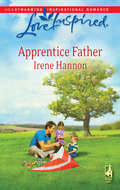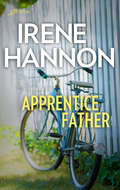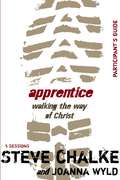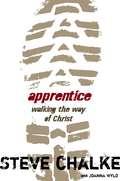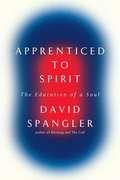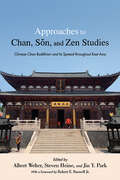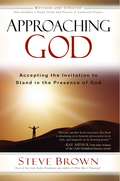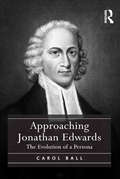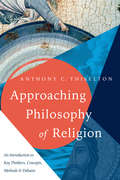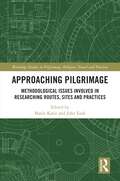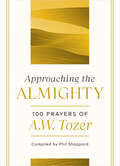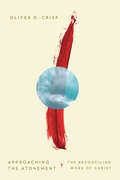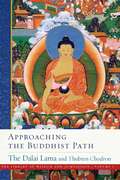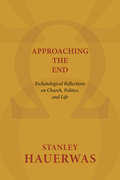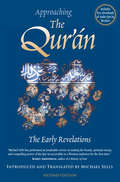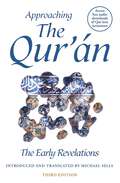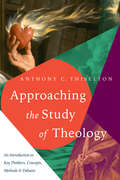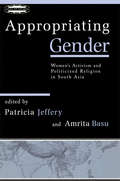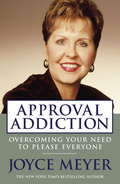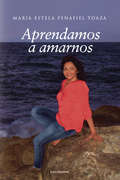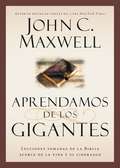- Table View
- List View
Apprentice Father
by Irene HannonHis orphaned niece and nephew are depending on Clay Adams. This commitment-phobe substitute dad needs help, and he needs it fast! Nanny Cate Shepard comes to his rescue just in the nick of time. Cate is no stranger to tragedy, and her deep, abiding faith has led her through her darkest days. With God's help, her kindness and nurturing can heal the children...but what about Clay? Will this father in the making abandon his lone-wolf ways to give Cate and the children the forever family they deserve?
Apprentice Father
by Irene HannonDaddy in TrainingHis orphaned niece and nephew are depending on Clay Adams. This commitment- phobe substitute dad needs help, and he needs it fast! Nanny Cate Shepard comes to his rescue just in the nick of time. Cate is no stranger to tragedy, and her deep, abiding faith has led her through her darkest days. With God’s help, her kindness and nurturing can heal the children... but what about Clay? Will this father in the making abandon his lone-wolf ways to give Cate and the children the forever family they deserve?Originally published in 2009
Apprentice Participant's Guide: Walking The Way Of Christ
by Steve ChalkeThe quest for meaning and purpose dwells within all of us. Jesus insisted that its fulfillment lay in a relationship with him. But what does that look like-really? Apprentice encourages us to ask our most probing questions, embrace our doubts and learn why we are driven to belong. Designed for use with the Apprentice five-session DVD study, use this participant’s guide as you follow bestselling author Steve Chalke in guiding us into a deep experience of learning and relationship with Jesus. Embarking on a relational journey that engages us on every level, we learn to walk with Jesus in an organic, whole-life learning experience, exploring areas foundational to the meaning and depth we crave. In five sessions the author covers the following topics. •Journeying: Life is like a journey best walked one step at a time •Longing: Satisfaction comes from longing for the things God longs for •Believing: Our knowledge is always limited, in the end we have to put our trust in something •Questioning: Without room for doubt, faith could not exist •Belonging: Living in community requires trust and love. It is dangerous and risky, but ultimately worth the risk
Apprentice: Walking the Way of Christ
by Steve Chalke Joanna WyldThe quest for meaning and purpose dwells within all of us. Jesus insisted that its fulfillment lay in a relationship with him. But what does that relationship look like—really? Apprentice calls spiritual pilgrims, both Christians and non-Christians, to exchange the shallow diversions of secular and religious culture for the pursuit of our true desires. In a book of refreshing honesty, great heart, and rich creativity, Steve Chalke guides us into an apprenticeship with the master teacher, Jesus. Embarking on a relational journey that engages us on every level, we walk with Jesus in an organic, whole-life learning experience, exploring ten areas foundational to the meaning and depth we crave. Apprentice encourages us to ask our most probing questions, embrace our doubts, and learn why we are driven to belong. Combining story and parable with thoughtful commentary, we discover the ancient art and discipline of apprenticeship— living lives stamped with the character, presence, and impact of Jesus.
Apprenticed to Spirit
by David SpanglerAn absorbing memoir of one man’s path to understanding how we can learn to lead lives of greater blessing and to be sources of blessing and service for the world as a whole. For as long as he can remember, David Spangler has been physically aware of a spiritual world existing alongside this one. In 1965, David Spangler left college to follow an inner spiritual calling and encountered an extraordinary presence, which he named “John. ” Over the next quarter-century John would assist David in exploring the “inner worlds” of the spirit, and would tutor him in some of the most basic mysteries of life and the nature of the human spirit. In Apprenticed to Spirit, Spangler recounts how John showed him the way to develop a spiritual intelligence—what Spangler calls “a mind of the soul”—and how to integrate it into everyday life. Spangler learned to think with his soul and embarked on the apprenticeship to understanding the sacredness of our world and of the realms beyond ours—a journey that continues to this day. .
Approaches to Chan, Sŏn, and Zen Studies: Chinese Chan Buddhism and Its Spread throughout East Asia (SUNY series in Chinese Philosophy and Culture)
by Albert Welter; Steven Heine; Jin Y. ParkThis volume focuses on Chinese Chan Buddhism and its spread across East Asia, with special attention to its impacts on Korean Sŏn and Japanese Zen. Zen enthralled the scholarly world throughout much of the twentieth century, and Zen Studies became a major academic discipline in its wake. Interpreted through the lens of Japanese Zen and its reaction to events in the modern world, Zen Studies incorporated a broad range of Zen-related movements in the East Asian Buddhist world. As broad as the scope of Zen Studies was, however, it was clearly rooted in a Japanese context, and aspects of the "Zen experience" that did not fit modern Japanese Zen aspirations tended to be marginalized and ignored. Approaches to Chan, Sŏn, and Zen Studies acknowledges the move beyond Zen Studies to recognize the changing and growing parameters of the field. The volume also examines the modern dynamics in each of these traditions.
Approaching God
by Steve BrownA spiritual guide on how to pray cites the importance of focusing on God rather than on oneself, while it defines the basic theology of prayer and addresses such issues as unanswered prayers.
Approaching God: How to Pray
by Steve BrownIn this book, Brown can help you experience the same kind of intimate relationship with God that he has discovered through learning how to pray.
Approaching Jonathan Edwards: The Evolution of a Persona
by Carol BallExploring the inner motivations of one of America’s greatest religious thinkers, this book analyses the ways in which Jonathan Edwards' intense personal piety and deep experience of divine sovereignty drove an introverted intellectual along a course that would eventually develop into a mature and respected public intellectual. Throughout his life, the tension between his innately contemplative nature and the active demands of public office was a constant source of internal and public strife for Edwards. Approaching Jonathan Edwards offers a new theoretical approach to the study of Edwards, with an emphasis on his writing activity as the key strategy in shaping his legacy. Tracing Edwards’ strategic self-fashioning of his persona through the many conflicts in which he was engaged, the critical turning points in his life, and his strategies for managing conflicts and crises, Carol Ball concludes that Edwards found his place as a superlative contemplative apologist and theorist of experiential spirituality.
Approaching Philosophy of Religion: An Introduction to Key Thinkers, Concepts, Methods and Debates
by Anthony C. ThiseltonApproaching Philosophy of ReligionApproaching Philosophy of Religion
Approaching Pilgrimage: Methodological Issues Involved in Researching Routes, Sites, and Practices (Routledge Studies in Pilgrimage, Religious Travel and Tourism)
by John Eade Mario KatićThis volume seeks to explore pilgrimage studies as a distinctive sub-field of research, and to define its key methodological approaches and problems. Pilgrimage studies has long been influenced by such academic disciplines as anthropology and this volume considers the new insights that pilgrimage studies can offer to these disciplinary fields. Bringing together experienced pioneers and a younger generation of pilgrimage scholars, the chapters address the directions contemporary pilgrimage research is taking and how it is developing into the future. Covering topics like digital pilgrimage, multi-site pilgrimages, and long-term ethnography, with examples from Europe, the Middle East, and Japan, this is an important resource for all researchers engaging with pilgrimage.
Approaching the Almighty: 100 Prayers of A. W. Tozer
by A. W. TozerDiscover the never-before-published prayers of A. W. Tozer as he opens his sermons.Is there a holier moment than when a preacher steps into the pulpit and opens the Scriptures before the people of the Lord? A. W. Tozer certainly understood the gravity and sanctity of that moment. His pulpit prayers reflect the holy awe that he experienced as he stood before God and the gathered congregation.Although Tozer fans are familiar with his writings and sermons, now for the first time, Approaching the Almighty collects the prayers that Tozer offered as he stepped into the pulpit to preach. Phil Shappard, a Moody Radio manager whose job was to remaster the audiotapes of Tozer&’s sermons, has collected and transcribed almost two hundred prayers that reveal the great preacher&’s intimate walk with God.The path to a rich prayer life is to pray alongside others whose faith is deep. Let Tozer&’s pulpit prayers guide your own heart in its steadfast pursuit of God.
Approaching the Almighty: 100 Prayers of A. W. Tozer
by A. W. TozerDiscover the never-before-published prayers of A. W. Tozer as he opens his sermons.Is there a holier moment than when a preacher steps into the pulpit and opens the Scriptures before the people of the Lord? A. W. Tozer certainly understood the gravity and sanctity of that moment. His pulpit prayers reflect the holy awe that he experienced as he stood before God and the gathered congregation.Although Tozer fans are familiar with his writings and sermons, now for the first time, Approaching the Almighty collects the prayers that Tozer offered as he stepped into the pulpit to preach. Phil Shappard, a Moody Radio manager whose job was to remaster the audiotapes of Tozer&’s sermons, has collected and transcribed almost two hundred prayers that reveal the great preacher&’s intimate walk with God.The path to a rich prayer life is to pray alongside others whose faith is deep. Let Tozer&’s pulpit prayers guide your own heart in its steadfast pursuit of God.
Approaching the Atonement: The Reconciling Work of Christ
by Oliver D. CrispIn many ways, the death of Jesus Christ on the cross stands at the heart of the Christian faith.
Approaching the Buddhist Path
by His Holiness the Dalai Lama Chodron ThubtenThe first volume in a multi-volume collection presenting the Dalai Lama’s comprehensive explanation of the Buddhist path.His Holiness the Dalai Lama has been publicly teaching Buddhism for decades. This series collects his presentations of every step of the path to enlightenment, compiled and coauthored by one of his chief Western disciples, the American nun Thubten Chodron. The Buddha wanted his students to investigate, to see for themselves whether what he said were true. As a student of the Buddha, the Dalai Lama promotes the same spirit of investigation, and as the rich tradition of the Buddha makes its way into new lands and cultures, His Holiness has recognized that new approaches are needed to allow seekers in the West to experience the relevance of the liberating message in their own lives. Such an approach cannot assume listeners are free from doubt and already have faith in Buddhism’s basic tenets. The Library of Wisdom and Compassion series, therefore, starts from the universal human wish for happiness and presents the dynamic nature of the mind. This first volume also provides a wealth of reflections on Buddhist history and fundamentals, contemporary issues, and the Dalai Lama’s own personal experiences. It stands alone as an introduction to Buddhism, but it also provides a foundation for the systematic illumination of the path in the volumes to come. The Library of Wisdom and Compassion collects the Dalai Lama’s decades of presentations of every step of the path to enlightenment. It has been compiled and coauthored by one of his chief Western disciples, the American nun Thubten Chodron.
Approaching the End: Eschatological Reflections on Church, Politics, and Life
by Stanley HauerwasIn this book Stanley Hauerwas explores the significance of eschatological reflection for helping the church negotiate the contemporary world.In Part One, "Theological Matters," Hauerwas directly addresses his understanding of the eschatological character of the Christian faith. In Part Two, "Church and Politics," he deals with the political reality of the church in light of the end, addressing such issues as the divided character of the church, the imperative of Christian unity, and the necessary practice of sacrifice. End, for Hauerwas, has a double meaning -- both chronological end and end in the sense of "aim" or "goal."In Part Three, "Life and Death," Hauerwas moves from theology and the church as a whole to focusing on how individual Christians should live in light of eschatology. What does an eschatological approach to life tell us about how to understand suffering, how to form habits of virtue, and how to die?
Approaching the Great Perfection
by Sam Van SchaikDzogchen, the Great Perfection, is the highest meditative practice of the Nyingma School of Tibetan Buddhism. Approaching the Great Perfection looks at a seminal figure of this lineage, Jigme Lingpa, an eighteenth-century scholar and meditation master whose cycle of teachings, the Longchen Nyingtig, has been handed down through generations as a complete path to enlightenment. Ten of Jigme Lingpa's texts are presented here, along with extensive analysis by van Schaik of a core tension within Buddhism: Does enlightenment develop gradually, or does it come all at once? Though these two positions are often portrayed by modern scholars as entrenched polemical views, van Schaik explains that both tendencies are present within each of the Tibetan Buddhist schools. He demonstrates how Jigme Lingpa is a great illustration of this balancing act, using the rhetoric of both sides to propel his students along the path of the Great Perfection.
Approaching the Qur'an: The Early Revelations
by Michael SellsApproaching the Qur'án is a major event in religious publishing. Professor Michael Sells has captured the complexity, power, and poetry of the early suras of the Qur'án, the sacred scripture of Islam. In this second edition, Sells introduces important new translations of suras and a new preface that addresses the ongoing controversy over teaching about Islam and the Qur'an in American universities. Approaching the Qur'án presents brilliant translations of the short, hymnic suras associated with the first revelations to the Prophet Muhammad. Most of these early revelations appear at the end of text and are commonly reached only by the most resolute reader of existing English translations. These suras contain some of the most powerful, prophetic and revelatory passages in religious history. They offer the vision of a meaningful and just life that anchors the religion of one-fifth of the world's inhabitants. Approaching the Qur'án is enriched by inclusion of free downloadable audio recordings of Quranic reciters, allowing readers an opportunity to hear the Qur'án in its original form. The book includes Sells' Introduction to the Qur'án, commentaries of the suras, a glossary of technical terms, and chapters discussing the sound nature and gender aspects of the Arabic text.
Approaching the Qur'an: The Early Revelations (third edition)
by Michael SellsApproaching the Qur&’an presents brilliant translations of the short, hymnic chapters, or Suras, associated with the first revelations to the Prophet Muhammad. These early Suras contain some of the most powerful, prophetic, and revelatory passages in religious history, offering the vision of a meaningful and just life that anchors the faith of one fifth of the world&’s inhabitants. In addition to these translations, Michael Sells provides an introduction to the Qur&’an, commentaries on the Suras, a glossary of technical terms, and discussions of the auditory nature and gender aspects of the Arabic text. An ideal resource for students and interested lay readers, this third edition also includes a new full Sura and associated commentary, a new preface, and a thoroughly updated bibliography.
Approaching the Study of Theology: An Introduction to Key Thinkers, Concepts, Methods & Debates
by Anthony C. ThiseltonFrom the opening pages of the Bible, we learn of God as one who communicates with humankind—offering us first steps toward knowledge of the divine, the very foothold of theology. On this basis, Approaching the Study of Theology presents an engaging introduction to the breadth and depth of the study of theology, mapping the significant landmarks as well as the main areas of debate. The book is divded into three parts: Part I (Approaches) describes the major approaches to theology that have emerged and developed over time. Part II (Concepts and Issues) explains the major concepts and issues, identifying theologians associated with each. Part III (Key Terms) provides a helpful glossary of all the key terms that readers need to understand in order to better understand theology. Written by the eminent theologian Anthony Thiselton, here is an accessible resource for both those in the midst of a theological course or program as well as those contemplating the field.
Appropriating Gender: Women's Activism and Politicized Religion in South Asia (Zones of Religion)
by Amrita Basu Patricia JefferyAppropriating Gender explores the paradoxical relationship of women to religious politics in India, Pakistan, Sri Lanka, and Bangladesh. Contrary to the hopes of feminists, many women have responded to religious nationalist appeals; contrary to the hopes of religious nationalists, they have also asserted their gender, class, caste, and religious identities; contrary to the hopes of nation states, they have often challenged state policies and practices. Through a comparative South Asia perspective, Appropriating Gender explores the varied meanings and expressions of gender identity through time, by location, and according to political context. The first work to focus on women's agency and activism within the South Asian context, Appropriating Gender is an outstanding contribution to the field of gender studies.
Approval Addiction: Overcoming Your Need To Please Everyone
by Joyce Meyer'There is an epidemic of insecurity in our society today. Many people are insecure and feel bad about themselves, which steals their joy and causes major problems in all their relationships.''The good news is that there is a cure for the approval addiction!'APPROVAL ADDICTION asks why so many of us have an overwhelming need for acceptance from the wider world - and provides the key to breaking free from this addiction.Joyce Meyer's groundbreaking book, now available with a new look for the B-format edition:· Demonstrates that you can accept who you are· Identifies the cause of our addictive need for approval· Helps you to be released from the chains of past· Guides you through steps to break the pattern for the futureJoyce writes from raw, personal knowledge of how insecurity and low self-esteem - stemming in her case from damaging childhood experiences - can leave us feeling constantly frustrated and lacking real peace or joy. It was through embracing the knowledge that she is unconditionally loved by God that she found inner security and the power to live her life to her full potential.
Approval Addiction: Overcoming the Need to Please Everyone
by Joyce MeyerThis book addresses the constant need some people have for approval from a religious perspective.
Aprendamos a amarnos
by María Estela Peñafiel ToazaHay cosas que llevo dentro de mí que las amo porque forman parte de mí ser desde el momento que se alojaron en mi cuerpo. Es un argumento basado en la vida real de dos mujeres que, en su tiempo, sufrieron; una de ellas, maltratos psicológicos y la segunda, ambas cosas solo por evitar que el llanto de sus hijos fuese silenciado en su propio vientre. Este tema tiene como característica principal contar la verdad, las lágrimas de dos madres que lloraban en la soledad tratando de encontrarle una salida sin perjudicar a ese ser maravilloso que su corazón ya latía dentro de su tripa. Al hacer este relato, la autora de este libro no trata de juzgar a nadie, sencillamente, quiere hacer una reflexión a todas aquellas personas que por falta de experiencia o por insensatez y no pensar en las consecuencias que nos pueden ocasionar ciertos recuerdos del pasado; hacerles entender que se perdieron o intentaron acabar con uno de los privilegios más lindos que el universo les estaba regalando. Con esto les confirma que tener amor propio es el comienzo de una vida llena de paz, amor y felicidad sin remordimientos.
Aprendamos de los Gigantes: Lecciones Tomadas de la Biblia Acerca de la Vida y el Liderazgo (Giants of the Bible)
by John C. MaxwellSi pudieras pasar tiempo en persona con los gigantes de la fe del Antiguo Testamento, ¿cómo sus percepciones afectarían tu vida? En este libro, John Maxwell se basa en más de cincuenta años estudiando la Biblia para transmitir la valiosa sabiduría de Elías, Eliseo, Job, Jacob, Débora, Isaías, Jonás, Josué y Daniel: Job forjó su fortaleza de carácter y se mostró optimista mientras se enfrentaba a una gran pérdida. Su reto para ti es: "¿Puedes mantenerte siendo positivo y fiel cuando las circunstancias son abrumadoras?"Débora fue escogida por Dios para ser una líder en un momento difícil. Ella te invita a que vuelvas a imaginar la envergadura de tu potencial: "Dios quiere sorprender al mundo a través de ti".Maxwell explora las historias notables de estos nueve héroes de la fe para compartir las lecciones eternas que puedes descubrir en cada una de ellas. Asimila sus experiencias y utiliza las preguntas de discusión para aprender sobre el liderazgo, sobre ti mismo y tu relación con Dios. La sabiduría que estos héroes comparten te ayudará a superar los retos de hoy.
